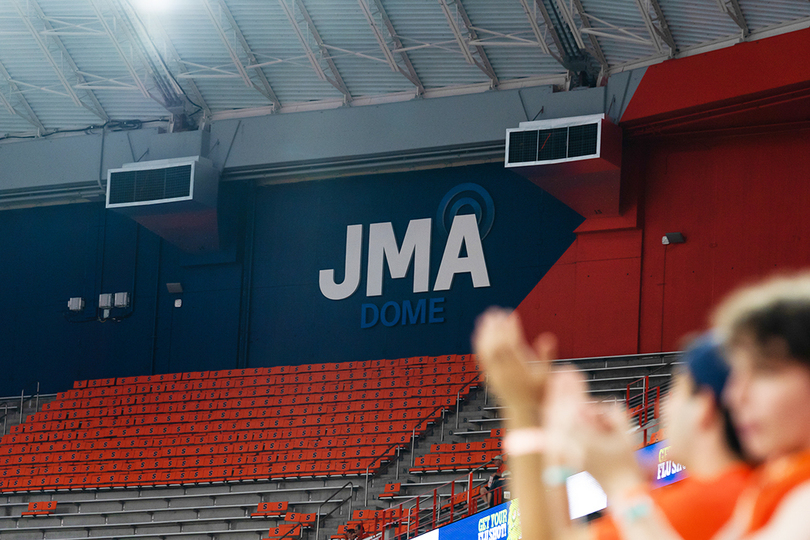SU, JMA Wireless partner to bring 5G to 3 residence halls

About 53% of students eligible for the JMA 5G pilot program have joined thus far, with 47% currently unable to join due to technological constraints. Emily Steinberger | Senior Staff Photographer
Get the latest Syracuse news delivered right to your inbox.
Subscribe to our newsletter here.
On move-in day this year, freshmen went through the typical move-in assembly line of any other year, receiving student IDs, room keys and the usual housekeeping information for their new home. But students living Day, Flint and Shaw Halls had another step to complete — connecting to Syracuse University’s new 5G network.
In partnership with JMA Wireless, SU rolled out a pilot 5G program to residents of the three dorms this semester. Over 1,500 students were eligible for the pilot, and just over 53% are now utilizing the network, said Jeff Rubin, the special advisor to the chancellor on digital transformation. JMA signed a 10-year naming rights deal for the Dome worth at least $3.25 million in May.
Getting onto the system was as simple as scanning a unique QR code, said Rubin, who is also a School of Information Studies professor.
“It took five minutes to set it up,” said Avery Fasulo, a freshman in the College of Arts and Sciences. “It’s been very fast, very efficient.”
Since the program started, the network’s speed has averaged up to a gigabit per second per device, Rubin said, which surpasses the speed of AirOrangeX. The new network does not act as a replacement, but a supplement to the university’s Wi-Fi and phone data plans, he said.
JMA and the university selected Flint, Shaw and Day due to their proximity and similarity. SU and JMA installed as much as they could over the summer, but if the pilot is successful the service will expand to other buildings on campus, he said.
The increase in online activity during the coronavirus pandemic spurred the university’s interest in improving its digital capabilities, said Sarah Scalese, SU’s senior associate vice president for communications.
“JMA is in our backyard and a great partner with us already so it made sense,” she said.
Though Masulo is grateful for the service, she said that once she walks out of her dorm, her 5G connection drops.
Jacob Charnow, another freshman living on the Mount, faced similar difficulties. He said he’s been doing his work inside due to the recent heat, but that the system would be even more helpful if it worked once he exits his dorm.

Santiago Noblin | Design Editor
Rubin said the service currently has hundreds of antennae and radios throughout Flint, Day and Shaw to navigate the different designs and barriers of each building. JMA is meant to work in conjunction with other systems, so once students leave their dorms, their phones should switch back to campus Wi-Fi or their regular cellular service.
But not all students are able to connect to the 5G network.
Alana Mitchell, who lives in Day Hall, said JMA staff told her that her phone wasn’t a new enough model to connect to the system. Mitchell has an iPhone X, which came out in 2017. The iPhone X does not have a virtual SIM, an unremovable chip embedded within the phone, or an eSim, which Rubin said is required to connect to the network.
A virtual sim card also acts as a secondary SIM to the one connecting to traditional carriers, which allows students to connect to 5G without replacing a phone’s carrier, Rubin said. Older phones use traditional SIM cards, which are physical chips that connect to a network’s provider.
Students with “locked” and “unlocked” phones will also have trouble accessing the new network, Rubin said. A “locked” is not completely paid off, such as those on upgrade plans, while “unlocked” phones are fully paid for. Rubin said the university is currently working with JMA to add locked devices to the network, which would allow it to connect to about 90% of eligible devices.
Still, some students not in the program expressed disinterest in joining.
“I’m fine with my data right now,” said Neil Sagare, a Mount resident. “I don’t need an upgrade or anything.”
Despite these sentiments, the new network has a lower latency – the delay between when a device requests data and when it is transferred – when compared to traditional WiFi, which improves speed for activities like gaming, Rubin said.
Students use an average of five gigabytes of data per month, which is a great rate, Rubin said. Still, he said the network may require some fine tuning, which would be an ongoing part of the current pilot program.
“So far, we’re happy with what we see,” Rubin said. “But it is very early.”





